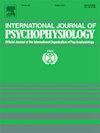The mediating role of social anxiety in the association between personality traits and Internet addiction and its underlying neural basis
IF 2.5
3区 心理学
Q3 NEUROSCIENCES
引用次数: 0
Abstract
Social anxiety (SA) is one of the most prevalent mental health problems in young adults. The significance of personality traits on the development of SA and the influence of SA on Internet addiction (IA) were increasingly emphasized. However, no studies yet have simultaneously examined the relationships among SA, personality traits, and IA, especially the role of SA and its underlying neural basis in the association between personality traits and IA. Therefore, this study was designed to address this question using behavioral and resting-state functional Magnetic Resonance Imaging (fMRI) measurements in a non-clinical sample of Chinese college students. Behavioral results indicated significant intercorrelations between Big Five personality traits, SA, and IA, with SA mediating the relationship between four personality traits (i.e., neuroticism, extraversion, openness, and conscientiousness) and IA. fMRI results showed that SA was negatively correlated with precuneus-occipital connectivity, which is associated with emotional face processing and self-focused attention. More importantly, the precuneus-occipital connectivity and SA played a chain mediating role in the association between the two personality traits (i.e., extraversion and openness) and IA. Together, these findings advanced our understanding of the psychological and neurobiological underpinnings of SA, especially its pivotal role in the relation between personality traits and IA.
社交焦虑在人格特质与网络成瘾关系中的中介作用及其潜在的神经基础
社交焦虑(SA)是年轻人中最普遍的心理健康问题之一。人格特质对网络成瘾发展的重要意义以及网络成瘾对网络成瘾的影响日益受到重视。然而,目前还没有研究同时考察SA、人格特质和IA之间的关系,特别是SA在人格特质和IA之间的作用及其潜在的神经基础。因此,本研究旨在通过对中国大学生非临床样本的行为和静息状态功能磁共振成像(fMRI)测量来解决这一问题。行为研究结果显示,大五人格特质、SA和IA之间存在显著的相互关系,其中SA在神经质、外向性、开放性和尽责性四种人格特质与IA之间起中介作用。fMRI结果显示,SA与枕叶前连通性呈负相关,枕叶前连通性与情绪面孔加工和自我关注有关。更重要的是,枕前连通性和SA在外向性和开放性两种人格特质与IA之间的关联中发挥了链式中介作用。总之,这些发现促进了我们对SA的心理和神经生物学基础的理解,特别是它在人格特质和IA之间的关系中的关键作用。
本文章由计算机程序翻译,如有差异,请以英文原文为准。
求助全文
约1分钟内获得全文
求助全文
来源期刊
CiteScore
5.40
自引率
10.00%
发文量
177
审稿时长
3-8 weeks
期刊介绍:
The International Journal of Psychophysiology is the official journal of the International Organization of Psychophysiology, and provides a respected forum for the publication of high quality original contributions on all aspects of psychophysiology. The journal is interdisciplinary and aims to integrate the neurosciences and behavioral sciences. Empirical, theoretical, and review articles are encouraged in the following areas:
• Cerebral psychophysiology: including functional brain mapping and neuroimaging with Event-Related Potentials (ERPs), Positron Emission Tomography (PET), Functional Magnetic Resonance Imaging (fMRI) and Electroencephalographic studies.
• Autonomic functions: including bilateral electrodermal activity, pupillometry and blood volume changes.
• Cardiovascular Psychophysiology:including studies of blood pressure, cardiac functioning and respiration.
• Somatic psychophysiology: including muscle activity, eye movements and eye blinks.

 求助内容:
求助内容: 应助结果提醒方式:
应助结果提醒方式:


